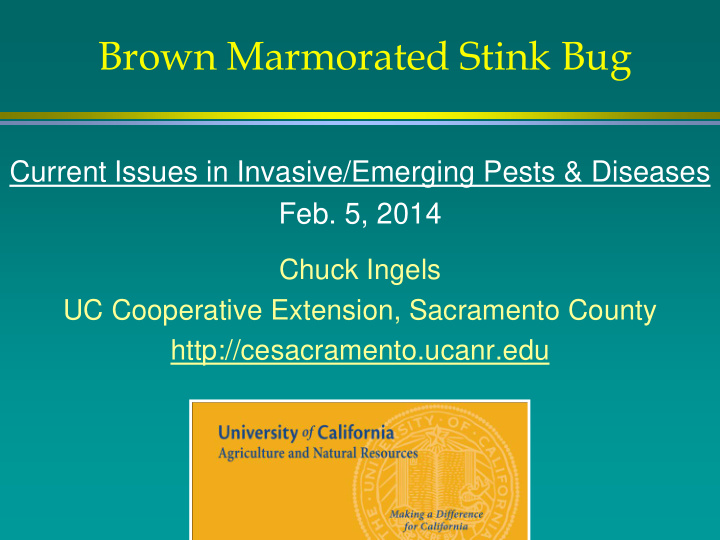



Brown Marmorated Stink Bug Current Issues in Invasive/Emerging Pests & Diseases Feb. 5, 2014 Chuck Ingels UC Cooperative Extension, Sacramento County http://cesacramento.ucanr.edu
Brown Marmorated Stink Bug ( Halyomorpha halys ) Photos: Baldo Villegas
Brown Marmorated Stink Bug ( Halyomorpha halys ) Native to East Asia (China, Japan, Korea, Taiwan) A crop pest in its native range and here Household nuisance pest in fall, winter Host list currently 170 spp., likely to rise
Current distribution in USA Source - http://www.stopbmsb.org T. Leskey, USDA-ARS May, 2012
Alameda BMSB Finds in Los Angeles Riverside California Sacramento San Diego San Francisco San Joaquin Solano Also: Santa Clara Butte Monterey Yolo San Luis Obispo Siskiyou Sutter Source - CDFA Plant Health and Pest Prevention Services Database, 2010
BMSB Finds in Sacramento County Oct. 15, 2013 Jan. 1, 2014 cesacramento.ucanr.edu
Pest Status in California “B” pest rating No major quarantine regulations Neither CDFA nor ag. commissioners conducting surveys or treatments
Adult Actual adult size Smooth 1/2 to 5/8 inch “shoulder” edges Two white bands Banded on antennae abdominal edge extending beyond wings Mature Banded legs nymph (5 th instar) Rust color with broad brown markings Photo: UC IPM
Eggs (20-30) & nymphs Nymph (3 rd of 5) Adult
USDA 5 Nymphal Instars Female Male Each adult lives 6-8 months Female can lays about 250 eggs Females mate multiple times ~2 generations in Mid-Atlantic states, 4-6 in southern China
Some Other True Bugs Red shouldered stink bugs Rough stink bug BMSB Photos: Consperse stink bug UC IPM
Rough Stink Bug vs. BMSB Rough stink bug BMSB
Rough Stink Bug vs. BMSB Rough stink bug BMSB Pointed Blunt Rough Smooth Narrower angle Wider angle
Host Plants Crops Stone fruits (esp. peach), pome fruits, citrus, persimmon, fig Berries Grapes (not a major host) Eggplant, tomato, okra, pepper, corn, beans (esp. soy), cucurbits, sunflower
Host Plants Selected Ornamentals Catalpa Princess tree ( Paulownia ) Chinese pistache Pyracantha Elm Redbud Maple Rose Holly Southern magnolia Mulberry Tree-of-heaven
Host Plants Nursery Plant Hosts Abelia Malus (crab apple) Acer (maple) Platanus (sycamore) Buddleia (butterfly bush) Prunus serotina (black cherry) Celosia Quercus (oak) Cercis (redbud) Syringa (lilac) Gleditsia (honey locust) Ulmus (elm) Hibiscus rosa-sinensis Zelkova serrata Lonicera ( honeysuckle)
Stink Bug Feeding
BMSB Damage
BMSB Damage Sweet Corn a High-Preference Crop Up to 100% of ears with injury, Beltsville MA 2011
Adult Aggregation Late summer/fall – adults seek overwinter sites in houses, under eaves, in leaf litter Annoys residents, odor when disturbed
BMSB An Arboreal Species
Aggregation Season, Pennsylvania Photos: Tracy Leskey
Aggregation Behavior Photos: Tracy Leskey
Overwintering behavior Photos: G. Hamilton
Phermone Trap Lures AgBio, Inc.: $4.25 (30 days) Rescue: $6 (4 wks.), $10 (9 wks.) Vaportape (kill bugs in trap)
Phermone Trap Dead-Inn Traps (AgBio, Inc.) Grower Professional Homeowner 48” tall, $30 24” tall, $20 16” tall, $17
Phermone Traps Rocket Trap (Rescue) $17
Insecticide Bioassay Results BMSB “lethality index” ( immediate mortality with little or no recovery) » 4.5 hrs. exposure to dry residue, glass containers » Field efficacy may differ
Active Ingredient Lethality Index Active Ingredient Lethality Index Dimethoate 93.3 Cyfluthrin 49.0 Malathion 92.5 Oxamyl 46.8 Bifenthrin 91.5 Esfenvalerate 43.3 Methidathion 90.4 Imidacloprid 40.0 Endosulfan 90.4 Tolfenpyrad (SC) 36.5 Methomyl 90.1 Tolfenpyrad (EC) 33.3 Chlorpyrifos 89.0 Pyrifluquinazon 28.3 Acephate 87.5 Kaolin Clay 23.1 Fenpropathrin 78.3 Diazinon 20.4 Permethrin 77.1 Phosmet 20.0 Azinphosmethyl 71.3 Acetamiprid 18.8 Dinotefuran 67.3 Thiacloprid 18.3 Kaolin Clay + Thiamethoxam 66.7 Abamectin 16.3 Formetanate HCl 63.5 Indoxacarb 11.3 Gamma-cyhalothrin 59.0 Spirotetramat 9.8 Thiamethoxam 56.3 Carbaryl 9.2 Clothianidin 55.6 Flonicamid 7.7 Beta-cyfluthrin 54.8 Water (Control) 5.8 Lambda-cyhalothrin 52.9 Cyantraniliprole 1.7 Zeta-cypermethrin 52.1 Tracy Leskey. 2011. The Challenges Posed by the Invasive Brown Marmorated Stink Bug, Halyomorpha halys (Stal), to U.S. Agriculture. USDA-ARS Appalachian Fruit Research Station, Kearneysville, WV
Insecticide Bioassay Results – Top 10 Active Trade Name Insecticide Lethality Ingredient (Example) Class Index Dimethoate Dimethoate OP 93.3 Malathion Malathion OP 92.5 Bifenthrin Brigade Pyrethroid 91.5 Methidathion Supracide OP 90.4 Endosulfan Thiodan Organochlor. 90.4 Methomyl Lannate Carbamate 90.1 Chlorpyrifos Lorsban OP 89.0 Acephate Orthene OP 87.5 Fenpropathrin Danitol Pyrethroid 78.3 Permethrin Pounce Pyrethroid 77.1
Pesticide Efficacy Field Study (Leskey et al., 2013) High mortality on BMSB adults exposed on the day of application: Endosulfan (e.g., Thiodan), methomyl (Lannate), thiamethoxam (Actara), and bifenthrin (e.g., Brigade) Fenpropathrin (Danitol) and dinetofuran (Venom) did not result in high mortality, but they had a strong anti-feeding effect for 7+ days Peaches in Mid-Atlantic: 10-12 weekly appli- cations, alternate-row, late May-harvest using pyrethroids and neonicotinoids
Organically Acceptable Insecticides Partial to fairly good control of nymphs only: Pyrethrum Azadirachtin Spinosad Sabadilla Insecticidal soap Combinations
Pesticide Efficacy Conclusions Wide range of effects within chemical classes » No chemical class outperformed all others Even at highest rates, BMSB very hard to kill via incidental/walking contact Effective insecticides in lab: only 60% average mortality in the field when applied late early July, 40% in Aug., and 20% in September
Alternative BMSB Management Penn. State Univ., Rutgers Univ. Border applications Use strong residual products Treat surrounding vegetation, if feasible Alternative crop plantings Possible trap crops (e.g., beans, Paulownia trees) Spray trap crops
Biological Control? Foreign exploration done by USDA Egg parasitoids - Trissolcus spp. Expected release in Calif. in 2016 Gymnosoma par
Questions? Important Web Sites StopBMSB.org ucipm.ucdavis.edu cesacramento.ucanr.edu
Recommend
More recommend